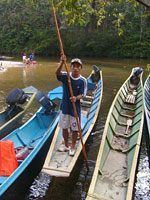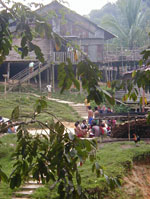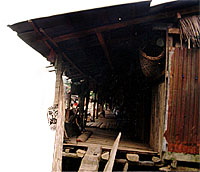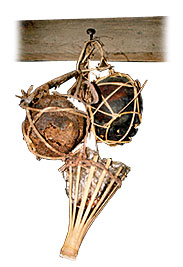
Page 1 | 2 | 3
 But along the shores of the endless, snaking rivers that carve through
the steamy rain forests of Borneo, tribal peoples have been living this
way - by choice - for thousands of years. Crime is practically unheard
of in these communities, along with divorce, child-abuse, and most of the
other social diseases the rest of the world resigns itself to every day.
These communities are called longhouses, and cultural tradition holds that
anyone who visits them is welcome to stay as long as they like. For many,
a visit to a longhouse offers not only a roof in the wilds of Borneo's
fantastic rain forest, but a glimpse into a way of life that is in many
ways an enviable model for communal living. Few people leave a longhouse
without being impressed by how smoothly its residents get along, how well-behaved
its children are, and the generosity of their hosts. But along the shores of the endless, snaking rivers that carve through
the steamy rain forests of Borneo, tribal peoples have been living this
way - by choice - for thousands of years. Crime is practically unheard
of in these communities, along with divorce, child-abuse, and most of the
other social diseases the rest of the world resigns itself to every day.
These communities are called longhouses, and cultural tradition holds that
anyone who visits them is welcome to stay as long as they like. For many,
a visit to a longhouse offers not only a roof in the wilds of Borneo's
fantastic rain forest, but a glimpse into a way of life that is in many
ways an enviable model for communal living. Few people leave a longhouse
without being impressed by how smoothly its residents get along, how well-behaved
its children are, and the generosity of their hosts.
 The most accessible longhouses belong to Sarawak's Iban tribe (also
called the Sea Dyaks) and are situated off the Skrang, Lemanak, Batang
Ai and Rejang River areas. Because of Borneo's impenetrable rain-forest,
getting to them almost inevitably involves a river ride in a long, pencil-thin
boat called a perahu - the workhorse of the Sarawakian waterways. It is
one of the most pleasureable forms of travel anywhere. These craft snake
briskly along the rivers, hypnotizing their riders with their droning engines
while they pass beneath huge, prehistoric-looking elipinat trees whose
roots cling to the river's edge like giant fists. Just when you think the
dreamlike scrolling of the forest wall will last forever, you turn one
of the endless, looping bends in the river, and suddenly a longhouse appears,
as if out of nowhere. The most accessible longhouses belong to Sarawak's Iban tribe (also
called the Sea Dyaks) and are situated off the Skrang, Lemanak, Batang
Ai and Rejang River areas. Because of Borneo's impenetrable rain-forest,
getting to them almost inevitably involves a river ride in a long, pencil-thin
boat called a perahu - the workhorse of the Sarawakian waterways. It is
one of the most pleasureable forms of travel anywhere. These craft snake
briskly along the rivers, hypnotizing their riders with their droning engines
while they pass beneath huge, prehistoric-looking elipinat trees whose
roots cling to the river's edge like giant fists. Just when you think the
dreamlike scrolling of the forest wall will last forever, you turn one
of the endless, looping bends in the river, and suddenly a longhouse appears,
as if out of nowhere.
 A typical longhouse
looks exactly like its name implies. It is a long, one-story dwelling,
covered by single roof usually woven of fronds from the ubiquitous sago
palm. It can stretch as long as a city block and have five hundred people
living in it, or it can house a community as small as a few dozen. The
families live in large rooms located off a main hall, a kind of social
center that stretches the length of the entire building. During the day,
when many of the residents are out working in the fields or forest, the
main hall is mostly empty, a peaceful, somnolent space of cool refuge.
If you stand on one end and look all the way down, you often see young
children playing quietly on intricately woven matts, always watched by
an older member of the community. In an environment where respect for each
other's space is essential to a healthy community, even the family dogs
seem to honor each other's small territory. They doze immediately in front
of each household, respecting their invisible barriers. A typical longhouse
looks exactly like its name implies. It is a long, one-story dwelling,
covered by single roof usually woven of fronds from the ubiquitous sago
palm. It can stretch as long as a city block and have five hundred people
living in it, or it can house a community as small as a few dozen. The
families live in large rooms located off a main hall, a kind of social
center that stretches the length of the entire building. During the day,
when many of the residents are out working in the fields or forest, the
main hall is mostly empty, a peaceful, somnolent space of cool refuge.
If you stand on one end and look all the way down, you often see young
children playing quietly on intricately woven matts, always watched by
an older member of the community. In an environment where respect for each
other's space is essential to a healthy community, even the family dogs
seem to honor each other's small territory. They doze immediately in front
of each household, respecting their invisible barriers.
 At night, just
after supper, the main hall livens up. Families come out to socialize and
guests gather in front of the chief's room. The chief's home is almost
always in the dead center of the building, and is often distinguished by
a fetish of antique human skulls - a reminder of the days when the Iban
and other tribes in Borneo practiced headhunting. The practice faded quickly
following the arrival of colonialism and the White Rajas of Sarawak, who
actively discouraged it. At night, just
after supper, the main hall livens up. Families come out to socialize and
guests gather in front of the chief's room. The chief's home is almost
always in the dead center of the building, and is often distinguished by
a fetish of antique human skulls - a reminder of the days when the Iban
and other tribes in Borneo practiced headhunting. The practice faded quickly
following the arrival of colonialism and the White Rajas of Sarawak, who
actively discouraged it.
>>continue
page 3
The Original Official Homepage
of the
Malaysia Tourism Promotion Board, New York

This page, and all contents
of this Web site are Copyright (c) 1996-2002 by interKnowledge Corp..
All rights reserved.
|
|

